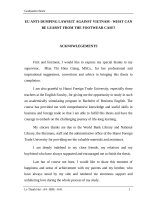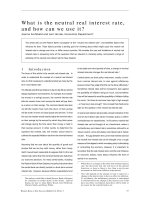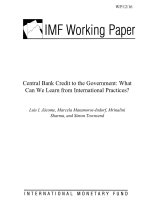The world until yesterday what can we learn from traditional societies
Bạn đang xem bản rút gọn của tài liệu. Xem và tải ngay bản đầy đủ của tài liệu tại đây (4.73 MB, 630 trang )
THE WORLD UNTIL YESTERDAY
WHAT CAN WE LEARN
FROM TRADITIONAL SOCIETIES?
Author: Jared Diamond
VIKING
eBook created (03/01/‘16): QuocSan
CONTENTS:
Also by Jared Diamond
Copyright
Dedication
List of Tables and Figures
Prologue
An airport scene
Why study traditional societies?
States
Types of traditional societies
Approaches, causes, and sources
A small book about a big subject
Plan of the book
PART I. SETTING THE STAGE BY DIVIDING SPACE
§1. Friends, Enemies, Strangers, and Traders
A boundary
Mutually exclusive territories
Non-exclusive land use
Friends, enemies, and strangers
First contacts
Trade and traders
Market economies
Traditional forms of trade
Traditional trade items
Table 1.1. Objects traded by some traditional societies
Who trades what?
Tiny nations
PART II. PEACE AND WAR
§2. Compensation for the Death of a Child
An accident
A ceremony
What if…?
What the state did
New Guinea compensation
Life-long relationships
Other non-state societies
State authority
State civil justice
Defects in state civil justice
State criminal justice
Restorative justice
Advantages and their price
§3. A Short Chapter, About a Tiny War
The Dani War
The war’s time-line
Table 3.1. Membership of two warring Dani alliances
The war’s death toll
§4. A Longer Chapter, About Many Wars
Definitions of war
Sources of information
Forms of traditional warfare
Mortality rates
Similarities and differences
Ending warfare
Effects of European contact
Warlike animals, peaceful peoples
Motives for traditional war
Ultimate reasons
Whom do people fight?
Forgetting Pearl Harbor
PART III. YOUNG AND OLD
§5. Bringing Up Children
Comparisons of child-rearing
Childbirth
Infanticide
Weaning and birth interval
On-demand nursing
Infant-adult contact
Fathers and allo-parents
Responses to crying infants
Physical punishment
Child autonomy
Multi-age playgroups
Child play and education
Their kids and our kids
§6. The Treatment of Old People: Cherish, Abandon, or Kill?
The elderly
Expectations about eldercare
Why abandon or kill?
Usefulness of old people
Society’s values
Society’s rules
Better or worse today?
What to do with older people?
PART IV. DANGER AND RESPONSE
§7. Constructive Paranoia
Attitudes towards danger
A night visit
A boat accident
Just a stick in the ground
Taking risks
Risks and talkativeness
§8. Lions and Other Dangers
Dangers of traditional life
Accidents
Table 8.1. Causes of accidental death and injury
Vigilance
Human violence
Diseases
Responses to diseases
Starvation
Unpredictable food shortages
Scatter your land
Seasonality and food shortage
Table 8.2. Traditional food storage around the world
Diet broadening
Aggregation and dispersal
Responses to danger
PART V. RELIGION, LANGUAGE, AND HEALTH
§9. What Electric Eels Tell Us About the Evolution of Religion
Questions about religion
Definitions of religion
Table 9.1. Some proposed definitions of religion
Functions and electric eels
The search for causal explanations
Table 9.2. Examples of supernatural beliefs confined to particular religions
Supernatural beliefs
Religion’s function of explanation
Defusing anxiety
Providing comfort
Organization and obedience
Codes of behavior towards strangers
Justifying war
Badges of commitment
Measures of religious success
Changes in religion’s functions
Figure 9.1 Religion’s functions changing through time
§10. Speaking in Many Tongues
Multilingualism
The world’s language total
How languages evolve
Geography of language diversity
Traditional multilingualism
Benefits of bilingualism
Alzheimer’s disease
Vanishing languages
How languages disappear
Are minority languages harmful?
Why preserve languages?
How can we protect languages?
§11. Salt, Sugar, Fat, and Sloth
Non-communicable diseases
Our salt intake
Salt and blood pressure
Causes of hypertension
Dietary sources of salt
Diabetes
Types of diabetes
Genes, environment, and diabetes
Pima Indians and Nauru Islanders
Diabetes in India
Table 11.1. Prevalences of Type-2 diabetes around the world
Benefits of genes for diabetes
Table 11.2. Examples of gluttony when food is abundantly available
Why is diabetes low in Europeans?
The future of non-communicable diseases
EPILOGUE
From the jungle to the 405
Advantages of the modern world
Advantages of the traditional world
What can we learn?
Acknowledgments
Further Readings
Index
Illustration Credits
Photo Insert
ALSO BY JARED DIAMOND
Collapse
Guns, Germs, and Steel
Why Is Sex Fun?
The Third Chimpanzee
Copyright
VIKING
Published by the Penguin Group
Penguin Group (USA) Inc., 375 Hudson Street, New York, New York 10014,
U.S.A.
Penguin Group (Canada), 90 Eglinton Avenue East, Suite 700, Toronto,
Ontario M4P 2Y3, Canada
(a division of Pearson Penguin Canada Inc.)
Penguin Books Ltd, 80 Strand, London WC2R 0RL, England
Penguin Ireland, 25 St. Stephen’s Green, Dublin 2, Ireland (a division of
Penguin Books Ltd)
Penguin Group (Australia), 707 Collins Street, Melbourne, Victoria 3008,
Australia
(a division of Pearson Australia Group Pty Ltd)
Penguin Books India Pvt Ltd, 11 Community Centre, Panchsheel Park, New
Delhi – 110 017, India
Penguin Group (NZ), 67 Apollo Drive, Rosedale, Auckland 0632, New
Zealand
(a division of Pearson New Zealand Ltd)
Penguin Books, Rosebank Office Park, 181 Jan Smuts Avenue, Parktown
North 2193, South Africa
Penguin China, B7 Jaiming Center, 27 East Third Ring Road North,
Chaoyang District,
Beijing 100020, China
Penguin Books Ltd, Registered Offices: 80 Strand, London WC2R 0RL,
England
First published in 2012 by Viking Penguin, a member of Penguin Group
(USA) Inc.
1 3 5 7 9 10 8 6 4 2
Copyright © Jared Diamond, 2012
All rights reserved
Photograph credits appear on page 499.
LIBRARY OF CONGRESS CATALOGING IN PUBLICATION DATA
Diamond, Jared M.
The world until yesterday: what can we learn from traditional societies? /
Jared Diamond.
p. cm.
Includes bibliographical references and index.
ISBN: 978-1-101-60600-1
1. Dani (New Guinean people)—History. 2. Dani (New Guinean people)—
Social life and customs. 3. Dani (New Guinean people)—Cultural
assimilation. 4. Social evolution—Papua New Guinea. 5. Social change—
Papua New Guinea. 6. Papua New Guinea—Social life and customs. I. Title.
DU744.35.D32D53 2013
305.89’912—dc23
2012018386
Designed by Nancy Resnick
Maps by Matt Zebrowski
No part of this book may be reproduced, scanned, or distributed in any
printed or electronic form without permission. Please do not participate in or
encourage piracy of copyrighted materials in violation of the author’s rights.
Purchase only authorized editions.
ALWAYS LEARNING — PEARSON
Dedication
To
Meg Taylor,
in appreciation for decades
of your friendship,
and of sharing your insights into our two worlds
List of Tables and Figures
Figure 1 — Locations of 39 societies that will be discussed frequently in
this book
Table 1.1 — Objects traded by some traditional societies
Table 3.1 — Membership of two warring Dani alliances
Table 8.1 — Causes of accidental death and injury
Table 8.2 — Traditional food storage around the world
Table 9.1 — Some proposed definitions of religion
Table 9.2 — Examples of supernatural beliefs confined to particular
religions
Figure 9.1 — Religion’s functions changing through time
Table 11.1 — Prevalences of Type-2 diabetes around the world
Table 11.2 — Examples of gluttony when food is abundantly available
PROLOGUE
At the Airport
An airport scene ▪ Why study traditional societies? ▪ States ▪ Types of
traditional societies ▪ Approaches, causes, and sources ▪ A small book about a
big subject ▪ Plan of the book
An airport scene
April 30, 2006, 7:00 A.M. I’m in an airport’s check-in hall, gripping my
baggage cart while being jostled by a crowd of other people also checking in
for that morning’s first flights. The scene is familiar: hundreds of travelers
carrying suitcases, boxes, backpacks, and babies, forming parallel lines
approaching a long counter, behind which stand uniformed airline employees
at their computers. Other uniformed people are scattered among the crowd:
pilots and stewardesses, baggage screeners, and two policemen swamped by
the crowd and standing with nothing to do except to be visible. The screeners
are X-raying luggage, airline employees tag the bags, and baggage handlers
put the bags onto a conveyor belt carrying them off, hopefully to end up in
the appropriate airplanes. Along the wall opposite the check-in counter are
shops selling newspapers and fast food. Still other objects around me are the
usual wall clocks, telephones, ATMs, escalators to the upper level, and of
course airplanes on the runway visible through the terminal windows.
The airline clerks are moving their fingers over computer keyboards and
looking at screens, punctuated by printing credit-card receipts at creditcard terminals. The crowd exhibits the usual mixture of good humor,
patience, exasperation, respectful waiting on line, and greeting friends.
When I reach the head of my line, I show a piece of paper (my flight
itinerary) to someone I’ve never seen before and will probably never see
again (a check-in clerk). She in turn hands me a piece of paper giving me
permission to fly hundreds of miles to a place that I’ve never visited
before, and whose inhabitants don’t know me but will nevertheless tolerate
my arrival.
To travelers from the U.S., Europe, or Asia, the first feature that would
strike them as distinctive about this otherwise familiar scene is that all the
people in the hall except myself and a few other tourists are New
Guineans. Other differences that would be noted by overseas travelers are
that the national flag over the counter is the black, red, and gold flag of the
nation of Papua New Guinea, displaying a bird of paradise and the
constellation of the Southern Cross; the counter airline signs don’t say
American Airlines or British Airways but Air Niugini; and the names of
the flight destinations on the screens have an exotic ring: Wapenamanda,
Goroka, Kikori, Kundiawa, and Wewak.
The airport at which I was checking in that morning was that of Port
Moresby, capital of Papua New Guinea. To anyone with a sense of New
Guinea’s history—including me, who first came to Papua New Guinea in
1964 when it was still administered by Australia—the scene was at once
familiar, astonishing, and moving. I found myself mentally comparing the
scene with the photographs taken by the first Australians to enter and
“discover” New Guinea’s Highlands in 1931, teeming with a million New
Guinea villagers still then using stone tools. In those photographs the
Highlanders, who had been living for millennia in relative isolation with
limited knowledge of an outside world, stare in horror at their first sight of
Europeans (Plates 30, 31). I looked at the faces of those New Guinea
passengers, counter clerks, and pilots at Port Moresby airport in 2006, and
I saw in them the faces of the New Guineans photographed in 1931. The
people standing around me in the airport were of course not the same
individuals of the 1931 photographs, but their faces were similar, and some
of them may have been their children and grandchildren.
The most obvious difference between that 2006 check-in scene etched in
my memory, and the 1931 photographs of “first contact,” is that New
Guinea Highlanders in 1931 were scantily clothed in grass skirts, net bags
over their shoulders, and headdresses of bird feathers, but in 2006 they
wore the standard international garb of shirts, trousers, skirts, shorts, and
baseball caps. Within a generation or two, and within the individual lives
of many people in that airport hall, New Guinea Highlanders learned to
write, use computers, and fly airplanes. Some of the people in the hall
might actually have been the first people in their tribe to have learned
reading and writing. That generation gap was symbolized for me by the
image of two New Guinea men in the airport crowd, the younger leading
the older: the younger in a pilot’s uniform, explaining to me that he was
taking the older one, his grandfather, for the old man’s first flight in an
airplane; and the gray-haired grandfather looking almost as bewildered and
overwhelmed as the people in the 1931 photos.
But an observer familiar with New Guinea history would have recognized
bigger differences between the 1931 and 2006 scenes, beyond the fact that
people wore grass skirts in 1931 and Western garb in 2006. New Guinea
Highland societies in 1931 lacked not just manufactured clothing but also
all modern technologies, from clocks, phones, and credit cards to
computers, escalators, and airplanes. More fundamentally, the New Guinea
Highlands of 1931 lacked writing, metal, money, schools, and centralized
government. If we hadn’t actually had recent history to tell us the result,
we might have wondered: could a society without writing really master it
within a single generation?
An attentive observer familiar with New Guinea history would have noted
still other features of the 2006 scene shared with other modern airport
scenes but different from the 1931 Highland scenes captured in the
photographs made by the first contact patrols. The 2006 scene contained a
higher proportion of gray-haired old people, relatively fewer of whom
survived in traditional Highland society. The airport crowd, while initially
striking a Westerner without previous experience of New Guineans as
“homogeneous”—all of them similar in their dark skins and coiled hair
(Plates 1, 13, 26, 30, 31, 32)—was heterogeneous in other respects of their
appearance: tall lowlanders from the south coast, with sparse beards and
narrower faces; shorter, bearded, wide-faced Highlanders; and islanders
and north coast lowlanders with somewhat Asian-like facial features. In
1931 it would have been utterly impossible to encounter Highlanders,
south coast lowlanders, and north coast lowlanders together; any gathering
of people in New Guinea would have been far more homogeneous than
that 2006 airport crowd. A linguist listening to the crowd would have
distinguished dozens of languages, falling into very different groups: tonal
languages with words distinguished by pitch as in Chinese, Austronesian
languages with relatively simple syllables and consonants, and non-tonal
Papuan languages. In 1931 one could have encountered individual
speakers of several different languages together, but never a gathering of
speakers of dozens of languages. Two widespread languages, English and
Tok Pisin (also known as Neo-Melanesian or Pidgin English), were the
languages being used in 2006 at the check-in counter and also for many of
the conversations among passengers, but in 1931 all conversations
throughout the New Guinea Highlands were in local languages, each of
them confined to a small area.
Another subtle difference between the 1931 and 2006 scenes was that the
2006 crowd included some New Guineans with an unfortunately common
American body type: overweight people with “beer bellies” hanging over
their belts. The photos of 75 years ago show not even a single overweight
New Guinean: everybody was lean and muscular (Plate 30). If I could have
interviewed the physicians of those airport passengers, then (to judge from
modern New Guinea public health statistics) I would have been told of a
growing number of cases of diabetes linked to being overweight, plus
cases of hypertension, heart disease, stroke, and cancers unknown a
generation ago.
Still another distinction of the 2006 crowd compared to the 1931 crowds
was a feature that we take for granted in the modern world: most of the
people crammed into that airport hall were strangers who had never seen
each other before, but there was no fighting going on among them. That
would have been unimaginable in 1931, when encounters with strangers
were rare, dangerous, and likely to turn violent. Yes, there were those two
policemen in the airport hall, supposedly to maintain order, but in fact the
crowd maintained order by itself, merely because the passengers knew that
none of those other strangers was about to attack them, and that they lived
in a society with more policemen and soldiers on call in case a quarrel
should get out of hand. In 1931 police and government authority didn’t
exist. The passengers in the airport hall enjoyed the right to fly or travel by
other means to Wapenamanda or elsewhere in Papua New Guinea without
requiring permission. In the modern Western world we have come to take
the freedom to travel for granted, but previously it was exceptional. In
1931 no New Guinean born in Goroka had ever visited Wapenamanda a
mere 107 miles to the west; the idea of traveling from Goroka to
Wapenamanda, without being killed as an unknown stranger within the
first 10 miles from Goroka, would have been unthinkable. Yet I had just
traveled 7,000 miles from Los Angeles to Port Moresby, a distance
hundreds of times greater than the cumulative distance that any traditional
New Guinea Highlander would have gone in the course of his or her
lifetime from his or her birthplace.
All of those differences between the 2006 and 1931 crowds can be
summed up by saying that, in the last 75 years, the New Guinea Highland
population has raced through changes that took thousands of years to
unfold in much of the rest of the world. For individual Highlanders, the
changes have been even quicker: some of my New Guinea friends have
told me of making the last stone axes and participating in the last
traditional tribal battles a mere decade before I met them. Today, citizens
of industrial states take for granted the features of the 2006 scene that I
mentioned: metal, writing, machines, airplanes, police and government,
overweight people, meeting strangers without fear, heterogeneous
populations, and so on. But all those features of modern human societies
are relatively new in human history. For most of the 6,000,000 years since
the proto-human and proto-chimpanzee evolutionary lines diverged from
each other, all human societies lacked metal and all those other things.
Those modern features began to appear only within the last 11,000 years,
in just certain areas of the world.
Thus, New Guinea* is in some respects a window onto the human world as
it was until a mere yesterday, measured against a time scale of the
6,000,000 years of human evolution. (I emphasize “in some respects”—of
course the New Guinea Highlands of 1931 were not an unchanged world
of yesterday.) All those changes that came to the Highlands in the last 75
years have also come to other societies throughout the world, but in much
of the rest of the world those changes appeared earlier and much more
gradually than in New Guinea. “Gradual,” however, is relative: even in
those societies where the changes appeared first, their time depth of less
than 11,000 years is still minuscule in comparison with 6,000,000 years.
Basically, our human societies have undergone profound changes recently
and rapidly.
Why study traditional societies?
Why do we find “traditional” societies so fascinating?* Partly, it’s because
of their human interest: the fascination of getting to know people who are so
similar to us and understandable in some ways, and so unlike us and hard to
understand in other ways. When I arrived in New Guinea for the first time, in
1964 at the age of 26, I was struck by the exoticness of New Guineans: they
look different from Americans, speak different languages, dress differently,
and behave differently. But over the subsequent decades, in the course of my
making dozens of visits of one to five months each to many parts of New
Guinea and neighboring islands, that predominant sense of exoticness yielded
to a sense of common ground as I came to know individual New Guineans:
we hold long conversations, laugh at the same jokes, share interests in
children and sex and food and sports, and find ourselves angry, frightened,
grief-stricken, relieved, and exultant together. Even their languages are
variations on familiar worldwide linguistic themes: although the first New
Guinea language that I learned (Fore) is unrelated to Indo-European
languages and hence has a vocabulary that was completely unfamiliar to me,
Fore still conjugates verbs elaborately like German, and it has dual pronouns
like Slovenian, postpositions like Finnish, and three demonstrative adverbs
(“here,” “there nearby,” and “there faraway”) like Latin.
All those similarities misled me, after my initial sense of New Guinea’s
exoticness, into thinking, “People are basically all the same everywhere.”
No, I eventually came to realize, in many basic ways we are not all the
same: many of my New Guinea friends count differently (by visual
mapping rather than by abstract numbers), select their wives or husbands
differently, treat their parents and their children differently, view danger
differently, and have a different concept of friendship. This confusing
mixture of similarities and differences is part of what makes traditional
societies fascinating to an outsider.
Another reason for the interest and importance of traditional societies is
that they retain features of how all of our ancestors lived for tens of
thousands of years, until virtually yesterday. Traditional lifestyles are what
shaped us and caused us to be what we are now. The shift from huntinggathering to farming began only about 11,000 years ago; the first metal
tools were produced only about 7,000 years ago; and the first state
government and the first writing arose only around 5,400 years ago.
“Modern” conditions have prevailed, even just locally, for only a tiny
fraction of human history; all human societies have been traditional for far
longer than any society has been modern. Today, readers of this book take
for granted farm-grown and store-bought food rather than wild food hunted
and gathered daily, tools of metal rather than of stone and wood and bone,
state government and its associated law courts and police and armies, and
reading and writing. But all of those seeming necessities are relatively
new, and billions of people around the world today still live in partly
traditional ways.
Embedded even within modern industrial societies are realms where many
traditional mechanisms still operate. In many rural areas of the First World,
such as the Montana valley where my wife and children and I spend our
annual summer vacations, many disputes are still resolved by traditional
informal mechanisms rather than by going to court. Urban gangs in large
cities don’t call the police to settle their disagreements but rely on
traditional methods of negotiation, compensation, intimidation, and war.
European friends of mine who grew up in small European villages in the
1950s described childhoods like those in a traditional New Guinea village:
everybody knew everybody else in the village, everyone knew what
everyone else was doing and expressed their opinions about it, people
married spouses born only a mile or two distant, people spent their entire
lives in or near the village except for young men away during the world
war years, and disputes within the village had to be settled in a way that
restored relationships or made them tolerable, because you were going to
be living near that person for the rest of your life. That is, the world of
yesterday wasn’t erased and replaced by a new world of today: much of
yesterday is still with us. That’s another reason for wanting to understand
yesterday’s world.
As we shall see in this book’s chapters, traditional societies are far more
diverse in many of their cultural practices than are modern industrial
societies. Within that range of diversity, many cultural norms for modern
state societies are far displaced from traditional norms and lie towards the
extremes of that traditional range of diversity. For example, compared to
any modern industrial society, some traditional societies treat elderly
people much more cruelly, while others offer elderly people much more
satisfying lives; modern industrial societies are closer to the former
extreme than to the latter. Yet psychologists base most of their
generalizations about human nature on studies of our own narrow and
atypical slice of human diversity. Among the human subjects studied in a
sample of papers from the top psychology journals surveyed in the year
2008, 96% were from Westernized industrial countries (North America,
Europe, Australia, New Zealand, and Israel), 68% were from the U.S. in
particular, and up to 80% were college undergraduates enrolled in
psychology courses, i.e., not even typical of their own national societies.
That is, as social scientists Joseph Henrich, Steven Heine, and Ara
Norenzayan express it, most of our understanding of human psychology is
based on subjects who may be described by the acronym WEIRD: from
Western, educated, industrialized, rich, and democratic societies. Most
subjects also appear to be literally weird by the standards of world cultural
variation, because they prove to be outliers in many studies of cultural
phenomena that have sampled world variation more broadly. Those
sampled phenomena include visual perception, fairness, cooperation,
punishment, biological reasoning, spatial orientation, analytic versus
holistic reasoning, moral reasoning, motivation to conform, making
choices, and concept of self. Hence if we wish to generalize about human
nature, we need to broaden greatly our study sample from the usual
WEIRD subjects (mainly American psychology undergraduates) to the
whole range of traditional societies.
While social scientists can thus surely draw conclusions of academic
interest from studies of traditional societies, all the rest of us may also be
able to learn things of practical interest. Traditional societies in effect
represent thousands of natural experiments in how to construct a human
society. They have come up with thousands of solutions to human
problems, solutions different from those adopted by our own WEIRD
modern societies. We shall see that some of those solutions—for instance,
some of the ways in which traditional societies raise their children, treat
their elderly, remain healthy, talk, spend their leisure time, and settle
disputes—may strike you, as they do me, as superior to normal practices in
the First World. Perhaps we could benefit by selectively adopting some of
those traditional practices. Some of us already do so, with demonstrated
benefits to our health and happiness. In some respects we moderns are
misfits; our bodies and our practices now face conditions different from
those under which they evolved, and to which they became adapted.
But we should also not go to the opposite extreme of romanticizing the
past and longing for simpler times. Many traditional practices are ones that
we can consider ourselves blessed to have discarded—such as infanticide,
abandoning or killing elderly people, facing periodic risk of starvation,
being at heightened risk from environmental dangers and infectious
diseases, often seeing one’s children die, and living in constant fear of
being attacked. Traditional societies may not only suggest to us some
better living practices, but may also help us appreciate some advantages of
our own society that we take for granted.
States
Traditional societies are more varied in their organization than are societies
with state government.* As a starting point to help us understand unfamiliar
features of traditional societies, let’s remind ourselves of the familiar features
of the nation-states in which we now live.
Most modern nations have populations of hundreds of thousands or
millions of people, ranging up to over a billion people each for India and
China, the two most populous modern nations. Even the smallest separate
modern nations, the Pacific island countries of Nauru and Tuvalu, contain
over 10,000 people each. (The Vatican, with a population of only 1,000
people, is also classified as a nation, but it’s exceptional as a tiny enclave
within the city of Rome, from which the Vatican imports all of its
necessities.) In the past as well, states had populations ranging from tens of
thousands up to millions. Those large populations already suffice to tell us
how states have to feed themselves, how they have to be organized, and
why they exist at all. All states feed their citizens primarily by means of
food production (agriculture and herding) rather than by hunting and
gathering. One can obtain far more food by growing crops or livestock on
an acre of garden, field, or pasture that we have filled with the plant and
animal species most useful to us, than by hunting and gathering whatever
wild animal and plant species (most of them inedible) happen to live in an
acre of forest. For that reason alone, no hunter-gatherer society has ever
been able to feed a sufficiently dense population to support a state
government. In any state, only a portion of the population—as low as 2%
in modern societies with highly mechanized farms—grows the food. The
rest of the population is busy doing other things (such as governing or
manufacturing or trading), doesn’t grow its own food, and instead subsists
off the food surpluses produced by the farmers.
The state’s large population also guarantees that most people within a state
are strangers to each other. It’s impossible even for citizens of tiny Tuvalu
to know all 10,000 of their fellow citizens, and China’s 1.4 billion citizens
would find the challenge even more impossible. Hence states need police,
laws, and codes of morality to ensure that the inevitable constant
encounters between strangers don’t routinely explode into fights. That
need for police and laws and moral commandments to be nice to strangers
doesn’t arise in tiny societies, in which everyone knows everyone else.
Finally, once a society tops 10,000 people, it’s impossible to reach,
execute, and administer decisions by having all citizens sit down for a
face-to-face discussion in which everyone speaks his or her mind. Large
populations can’t function without leaders who make the decisions,
executives who carry out the decisions, and bureaucrats who administer the
decisions and laws. Alas for all of you readers who are anarchists and
dream of living without any state government, those are the reasons why
your dream is unrealistic: you’ll have to find some tiny band or tribe
willing to accept you, where no one is a stranger, and where kings,
presidents, and bureaucrats are unnecessary.
We’ll see in a moment that some traditional societies were populous
enough to need general-purpose bureaucrats. However, states are even
more populous and need specialized bureaucrats differentiated vertically
and horizontally. We state citizens find all those bureaucrats exasperating:
alas again, they’re necessary. A state has so many laws and citizens that
one type of bureaucrat can’t administer all of the king’s laws: there have to
be separate tax collectors, motor vehicle inspectors, policemen, judges,
restaurant cleanliness inspectors, and so on. Within a state agency
containing just one such type of bureaucrat, we’re also accustomed to the
fact that there are many officials of that one type, arranged hierarchically
on different levels: a tax agency has the tax agent who actually audits your
tax return, serving under a supervisor to whom you might complain if you
disagree with the agent’s report, serving in turn under an office manager,
serving under a district or state manager, serving under a commissioner of
internal revenue for the whole United States. (It’s even more complicated
in reality: I omitted several other levels for the sake of brevity.) Franz
Kafka’s novel The Castle describes an imaginary such bureaucracy
inspired by the actual bureaucracy of the Habsburg Empire of which Kafka
was a citizen. Bedtime reading of Kafka’s account of the frustrations faced
by his protagonist in dealing with the imaginary castle bureaucracy
guarantees me a sleep filled with nightmares, but all of you readers will
have had your own nightmares and frustrations from dealing with actual
bureaucracies. It’s the price we pay for living under state governments: no
utopian has ever figured out how to run a nation without at least some
bureaucrats.
A remaining all-too-familiar feature of states is that, even in the most
egalitarian Scandinavian democracies, citizens are politically,
economically, and socially unequal. Inevitably, any state has to have a few
political leaders giving orders and making laws, and lots of commoners
obeying those orders and laws. State citizens have different economic roles
(as farmers, janitors, lawyers, politicians, shop clerks, etc.), and some of
those roles carry higher salaries than do other roles. Some citizens enjoy
higher social status than do other citizens. All idealistic efforts to minimize
inequality within states—e.g., Karl Marx’s formulation of the communist
ideal “From each according to his abilities, to each according to his
needs”—have failed.
There could be no states until there was food production (beginning only
around 9000 BC), and still no states until food production had been
operating for enough millennia to build up the large, dense populations
requiring state government. The first state arose in the Fertile Crescent
around 3400 BC, and others then arose in China, Mexico, the Andes,
Madagascar, and other areas over the following millennia, until today a
world map shows the entire planet’s land area except for Antarctica
divided into states. Even Antarctica is subject to partly overlapping
territorial claims by seven nations.









